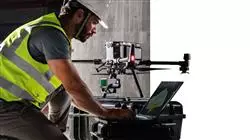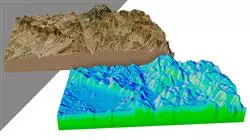University certificate
Scientific endorser

The world's largest faculty of engineering”
Introduction to the Program
This program will give you access to the most advanced knowledge in Geomatics and Geoinformation so that you can incorporate the best tools available into your work”

New technological and digital tools have allowed disciplines such as Geomatics to improve their precision and efficacy. The emergence of these disruptive technologies has also led to the emergence of new professional profiles in this area such as the expert surveyor, the GIS specialist or the expert in 3D modeling focused on this sector. For this reason, professionals dedicated to this field must be aware of new innovations in order to be able to incorporate them into their work.
This Masters Degree in Geomatics Engineering and Geoinformation provides in-depth knowledge of these innovations, focusing on areas such as photogrammetry, geopositioning, applied information in this field; especially programming and the design and management of databases, using drones to represent terrain through photographic images, and many more. In this way, professionals will integrate the most innovative techniques into their daily work, allowing them to adapt to transformations in the sector and gain access to the new job positions that have recently emerged.
And all this will be achieved through an online teaching methodology, specially designed so that the professional can combine their work with their studies, without any kind of interruption. In addition, they will be guided throughout the entire process by a first-class teaching staff with extensive experience in this field, while the student enjoys numerous multimedia contents such as interactive summaries, practical exercises or master classes.
Gain in-depth knowledge of aspects such as photogrammetry while you enjoy a teaching methodology that is adapted to you, allowing you to decide when and where to study”
This Masters Degree in Geomatics Engineering and Geoinformation contains the most complete and up-to-date program on the market. Its most notable features are:
- Practical cases presented by experts in Topographpy, Civil Engineering and Geomatics
- The graphic, schematic, and practical contents with which they are created, provide scientific and practical information on the disciplines that are essential for professional practice
- Practical exercises where the self-assessment process can be carried out to improve learning
- Special emphasis on innovative methodologies
- Theoretical lessons, questions to the expert, debate forums on controversial topics, and individual reflection assignments
- Content that is accessible from any fixed or portable device with an Internet connection
In recent years, many new professional profiles have emerged in the field of Geomatics, such as the expert surveyor. This program gives you all the keys to successfully deal with this transformation”
The teaching staff of this program includes professionals from the sector, who contribute the experience of their work to this program, in addition to recognized specialists from reference societies and prestigious universities.
Thanks to multimedia content developed with the latest educational technology, you will be immersed in situated and contextual learning. In other words, a simulated environment that will provide immersive learning, programmed to train for real situations.
This program is designed around Problem-Based Learning, whereby the professional must try to solve the different professional practice situations that arise throughout the program. For this purpose, the student will be assisted by an innovative interactive video system created by renowned and experienced experts.
Thanks to this program, you will learn how to use drones map and represent the terrain by means of photographic images"

Know the latest computer tools applied to Geomatics with this Masters Degree"
Why study at TECH?
TECH is the world’s largest online university. With an impressive catalog of more than 14,000 university programs available in 11 languages, it is positioned as a leader in employability, with a 99% job placement rate. In addition, it relies on an enormous faculty of more than 6,000 professors of the highest international renown.

Study at the world's largest online university and guarantee your professional success. The future starts at TECH”
The world’s best online university according to FORBES
The prestigious Forbes magazine, specialized in business and finance, has highlighted TECH as “the world's best online university” This is what they have recently stated in an article in their digital edition in which they echo the success story of this institution, “thanks to the academic offer it provides, the selection of its teaching staff, and an innovative learning method aimed at educating the professionals of the future”
A revolutionary study method, a cutting-edge faculty and a practical focus: the key to TECH's success.
The most complete study plans on the university scene
TECH offers the most complete study plans on the university scene, with syllabuses that cover fundamental concepts and, at the same time, the main scientific advances in their specific scientific areas. In addition, these programs are continuously being updated to guarantee students the academic vanguard and the most in-demand professional skills. In this way, the university's qualifications provide its graduates with a significant advantage to propel their careers to success.
TECH offers the most comprehensive and intensive study plans on the current university scene.
A world-class teaching staff
TECH's teaching staff is made up of more than 6,000 professors with the highest international recognition. Professors, researchers and top executives of multinational companies, including Isaiah Covington, performance coach of the Boston Celtics; Magda Romanska, principal investigator at Harvard MetaLAB; Ignacio Wistumba, chairman of the department of translational molecular pathology at MD Anderson Cancer Center; and D.W. Pine, creative director of TIME magazine, among others.
Internationally renowned experts, specialized in different branches of Health, Technology, Communication and Business, form part of the TECH faculty.
A unique learning method
TECH is the first university to use Relearning in all its programs. It is the best online learning methodology, accredited with international teaching quality certifications, provided by prestigious educational agencies. In addition, this disruptive educational model is complemented with the “Case Method”, thereby setting up a unique online teaching strategy. Innovative teaching resources are also implemented, including detailed videos, infographics and interactive summaries.
TECH combines Relearning and the Case Method in all its university programs to guarantee excellent theoretical and practical learning, studying whenever and wherever you want.
The world's largest online university
TECH is the world’s largest online university. We are the largest educational institution, with the best and widest online educational catalog, one hundred percent online and covering the vast majority of areas of knowledge. We offer a large selection of our own degrees and accredited online undergraduate and postgraduate degrees. In total, more than 14,000 university degrees, in eleven different languages, make us the largest educational largest in the world.
TECH has the world's most extensive catalog of academic and official programs, available in more than 11 languages.
Google Premier Partner
The American technology giant has awarded TECH the Google Google Premier Partner badge. This award, which is only available to 3% of the world's companies, highlights the efficient, flexible and tailored experience that this university provides to students. The recognition as a Google Premier Partner not only accredits the maximum rigor, performance and investment in TECH's digital infrastructures, but also places this university as one of the world's leading technology companies.
Google has positioned TECH in the top 3% of the world's most important technology companies by awarding it its Google Premier Partner badge.
The official online university of the NBA
TECH is the official online university of the NBA. Thanks to our agreement with the biggest league in basketball, we offer our students exclusive university programs, as well as a wide variety of educational resources focused on the business of the league and other areas of the sports industry. Each program is made up of a uniquely designed syllabus and features exceptional guest hosts: professionals with a distinguished sports background who will offer their expertise on the most relevant topics.
TECH has been selected by the NBA, the world's top basketball league, as its official online university.
The top-rated university by its students
Students have positioned TECH as the world's top-rated university on the main review websites, with a highest rating of 4.9 out of 5, obtained from more than 1,000 reviews. These results consolidate TECH as the benchmark university institution at an international level, reflecting the excellence and positive impact of its educational model.” reflecting the excellence and positive impact of its educational model.”
TECH is the world’s top-rated university by its students.
Leaders in employability
TECH has managed to become the leading university in employability. 99% of its students obtain jobs in the academic field they have studied, within one year of completing any of the university's programs. A similar number achieve immediate career enhancement. All this thanks to a study methodology that bases its effectiveness on the acquisition of practical skills, which are absolutely necessary for professional development.
99% of TECH graduates find a job within a year of completing their studies.
Master’s Degree in Geomatics Engineering and Geoinformation
Geomatics engineering and geoinformation is a discipline that combines the knowledge of engineering, geodesy and cartography to acquire, manage, analyze and visualize geospatial data. This discipline is responsible for capturing and processing information related to the location and distribution of features on the earth's surface. In an increasingly digitized and globalized world, the demand for professionals specialized in the field of geomatics engineering and geoinformation is constantly growing. Under this premise, TECH Global University presents its Master’s Degree in Geomatics Engineering and Geoinformation, a detailed look at the multiplicity of schemes that take place in this field. Here, we propose an entirely online tour, through which you will obtain the skills and knowledge necessary to master the most advanced technologies in the capture, analysis and visualization of geospatial data. All this, without having to leave home, with the best teaching tutorials and interactive material that will give that rewarding plus to your professional profile.
Highlight in the field of geomatics engineering and geoinformation
This complete TECH program is an investment in your professional future, as it will allow you to differentiate yourself and stand out in the labor market. You will obtain a university certificate endorsed by a prestigious institution, which will allow you to access new job opportunities. You will also have the flexibility and convenience of a online program that will allow you to adapt your learning to your needs and schedules. Here, we have ensured that we have a team of professional experts in the field, who will teach the classes online, offering an interactive and enriching learning experience. In addition, the program includes case studies and exercises that will allow you to apply the knowledge acquired in real situations, which will help you to strengthen and consolidate your academic preparation. Upon completion of the program, you will develop solid skills in global positioning systems, remote sensing, spatial analysis and geographic information systems.







